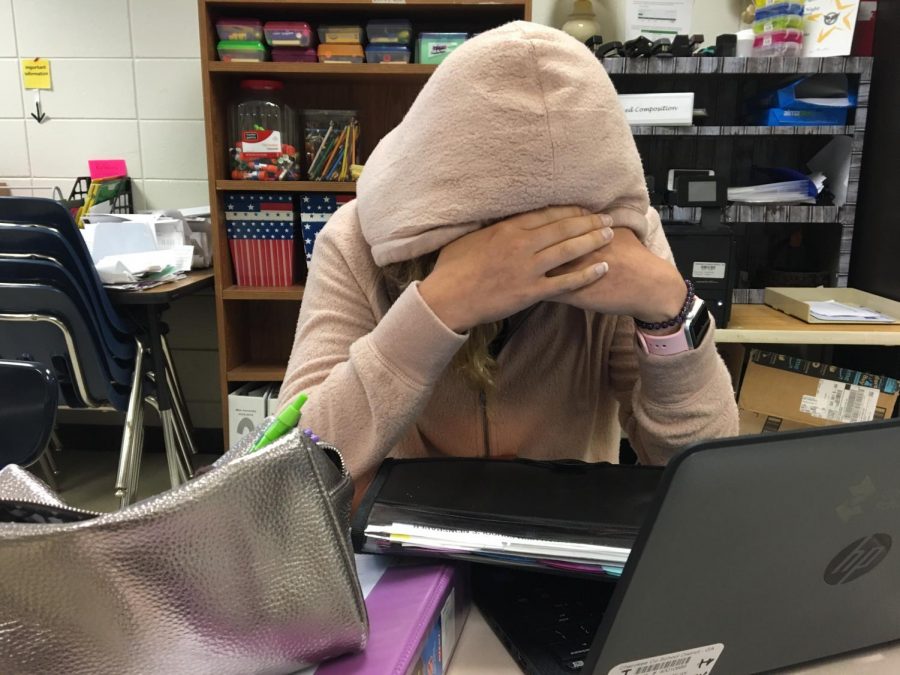Taking a toll
Homework. Stress. Repeat.
The average student has probably experienced a mental breakdown before, whether it be in the company of their peers at school or in the comfort of their own home. For a while, many researchers believed that students were experiencing the “good stress”, the kind that pushes them to work hard and expand the boundaries of their comfort zone. However, modern studies show that is not the case, and the chronic stress they suffer from can lead to mental health problems.
Coming-of-age movies depict the life of a high schooler to be glamorous, where teens worry only about dating and drama, not about the huge AP test on Friday or applying to college and getting scholarships. In fact, PEW Research shows that 70% of teens struggle with some kind of mental illness, most commonly depression or anxiety, which is typically not talked about in the media.
“I think the way it’s [mental health] talked about makes people laugh about it and treat it like a joke, which makes those who suffer from mental illness even less likely to speak up,” Abby Madsen, junior, said.
It is often extremely difficult for teens to talk about what they are experiencing day to day, and many times these confessions get brushed aside as a part of growing up and becoming adults. If children are upset or confine themselves to their room for days at a time, it is just them being moody. If they sleep in and do not socialize or leave the house much, then they are lazy and unmotivated.
“I know a lot of people whose parents think their anxiety and depression is just normal stress, or they just don’t want to admit their kid has something wrong with them because of the stigma around mental health,” Delaney Stemmerman, senior, said.
Although there are many signs that a teen might be silently struggling, many people blame it on our generation rather than extending a helping hand when it could be needed. Spreading awareness about mental illness, especially in school, is vital to keeping students safe and on the path towards a bright and long future.
How to: spot the symptoms
As common as anxiety and depression have been proven to be among teenagers, many people suffering from these mental health issues do not voice their feelings to others. In order for students and teachers alike to help children in their struggles, they must first read the signs.
One of the first and most common indications of anxiety that is seen in the classroom is inattentiveness and restless behavior. Although some kids may truly be slacking off, students with anxiety often become consumed with their thoughts and worries and are unable to focus on lectures. From tapping a pen or pencil to bouncing their knee rapidly, students who struggle with anxiety often cannot sit still.
Another common theme is isolating themselves during group work and not socializing with other students. Rather than meeting and working with new friends in a class, students who struggle with anxiety tend to confine themselves and work alone.
Anxiety is also not limited to just the brain of a student; it can also be the cause of real illnesses and physical pains. Anxiety can manifest itself into frequent headaches, stomach aches, and nausea, as well as smaller things such as sweaty palms and being out of breath. Frequent trips to the nurse or physical complaints can be key indicators that a student is experiencing anxiety.
Though depression is harder to spot, there are still some key symptoms. Students struggling with depression often deal with fatigue, insomnia, sleeping too much, and paying less attention to personal appearance. They may also experience changes in attitude and appetite and may start performing poorly in school.
It may be daunting to try and make sure the students in a class are comfortable, but if children are suffering with anxiety or depression, allowing them to get some air can give them the time they need to calm down and continue to work successfully.
Mental illness in the media
With the growth of society over the years into a more accepting space for many people, the media has shifted along with it. More and more movies, television shows, news articles, and celebrities are addressing sensitive topics that did not used to be up for public discussion, one of those topics being mental illness.
“I think it’s important for celebrities, movies, and the media to talk about mental health because they need to use their fame to show how it can affect people,” Lauren Giesler, freshman, said.
From series like “BoJack Horseman” and “This Is Us” to movies like “Iron Man 3” and “The Perks Of Being a Wallflower,” production companies are continuing to delve further into the realm of mental health. Creators and directors are now openly sharing the struggles that characters like Tony Stark and Randall Pearson deal with when it comes to anxiety, as well as accurately portraying depression through characters like BoJack.
“It [television] was very important to me, as well as other mentally ill people, because it shows that we can still be the protagonists of our own story and that we don’t have to be defined by our mental illness,” Audrey Leamon, sophomore, said.
Throughout the past few years, many celebrities have opened up about mental health and the illnesses they struggle with. Selena Gomez and Justin Bieber have both spoken about depression and anxiety and have taken breaks on tours to focus on their personal well-being. After the bombing at her concert in Manchester, England, Ariana Grande has also talked about her struggle with PTSD and how is has been affecting her everyday life.
“Many people think all these celebrities have perfect lives, but if they were more open about their mental health, I think more people would realize they aren’t alone in their problems,” Tristin Davis, junior, said.
The mention of mental illness in the public can be a polarizing subject. Some think that mental health becoming a focal point of society has helped those who are struggling reach out and feel accepted, while others think that talking about it is doing more damage. No matter how a person feels about mental illness, studies have proven that it is more common than ever among high school students, and the media is beginning to reflect that.
You are not alone
No matter who you are or what your story is, the chances are you have been through some kind of struggle. Whether it was overcoming senioritis this year or moving through tough circumstances, everyone goes through different experiences that put their strength to the test.
If you think someone you know may be struggling, do not be afraid to reach out. It may be scary, but it is so important to let your friends know that you are there for them. A little extra kindness to someone really can go a long way, as cheesy as it sounds.
Secondly, if you are someone who’s struggling with mental illness, it is okay to ask for help. You are not weak, and there is nothing to be ashamed of. It is always okay to open up to others, no matter how challenging it may be to try and explain your feelings. In the end, talking to someone you trust might be what you need to see the light at the end of the tunnel again.
For more information on how you can reach out to talk to someone, click here.

Hi! My name is Haley James, and this is my fourth year on The Talon. This year I am Editor-In-Chief, and I am so excited to end my high school career on...






